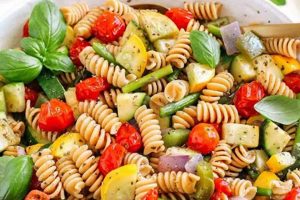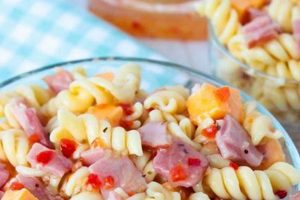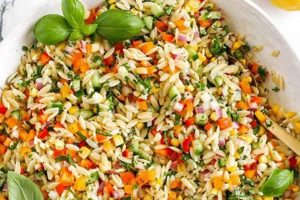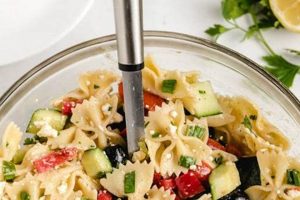Quick-to-prepare, chilled pasta dishes often combine cooked pasta, vegetables, a protein source (such as cheese, beans, or meat), and a flavorful dressing. A classic example might include rotini pasta, chopped bell peppers, cubed cheddar cheese, and a vinaigrette. Variations are endless, accommodating diverse dietary needs and preferences.
These dishes offer convenience, versatility, and nutritional value. Ideal for potlucks, picnics, or light meals, they can be made ahead of time and are easily customizable with seasonal ingredients. Historically, pasta salads, drawing inspiration from Mediterranean and European cuisines, gained popularity as refrigeration became more commonplace, allowing for safe consumption of cold, prepared dishes.
The following sections will explore key elements of crafting these dishes, including pasta selection, dressing options, ingredient pairings, and tips for optimal flavor and texture.
Tips for Creating Delicious Pasta Salads
Achieving a well-balanced and flavorful pasta salad requires attention to detail. These tips offer guidance for optimal results.
Tip 1: Cook Pasta Al Dente: Pasta cooked until firm to the bite provides the best texture for salads. Overcooked pasta becomes mushy and absorbs less dressing.
Tip 2: Rinse Cooked Pasta: Rinsing pasta under cold water stops the cooking process and removes excess starch, preventing a sticky salad.
Tip 3: Choose the Right Dressing: A light, flavorful dressing complements the other ingredients without overpowering them. Vinaigrettes, creamy dressings made with yogurt or mayonnaise, and pesto are popular choices.
Tip 4: Incorporate Varied Ingredients: A combination of textures and flavors enhances the salad. Consider adding crisp vegetables, protein sources like beans or cheese, and herbs for a well-rounded dish.
Tip 5: Dress the Salad Just Before Serving: Adding the dressing shortly before serving prevents the pasta and vegetables from becoming soggy.
Tip 6: Season Appropriately: Taste and adjust seasonings throughout the preparation process. Salt, pepper, and other herbs and spices can elevate the overall flavor profile.
Tip 7: Chill Thoroughly: Chilling the salad allows the flavors to meld and provides a refreshing dining experience.
By following these guidelines, one can create a satisfying and flavorful pasta salad suitable for various occasions.
These practical tips pave the way for creating personalized pasta salads that delight the palate. The concluding section will summarize key learnings and offer further inspiration.
1. Easy Preparation
Ease of preparation is a defining characteristic of simple pasta salad recipes. This attribute stems from several factors, including readily available ingredients, minimal cooking requirements, and straightforward assembly. The time commitment for creating such a dish is often significantly less than for more complex meals. For instance, a basic pasta salad might involve cooking pasta, chopping a few vegetables, and combining them with a pre-made dressinga process achievable within 30 minutes. This accessibility makes pasta salads a practical choice for weeknight dinners, quick lunches, or potluck contributions.
The emphasis on simplified preparation often influences ingredient selection. Recipes frequently utilize pre-cut vegetables, canned beans, or pre-cooked proteins like rotisserie chicken to further reduce active cooking time. Similarly, dressings can range from simple vinaigrettes to store-bought options, offering flexibility based on available time and resources. This adaptability contributes to the widespread appeal of these recipes, catering to both novice cooks and experienced chefs seeking convenient meal solutions. Furthermore, the ease of preparation makes these dishes ideal for scaling up or down, accommodating both small and large gatherings with minimal effort.
Ultimately, the ease of preparation associated with simple pasta salad recipes significantly contributes to their popularity. This characteristic democratizes culinary creativity, allowing individuals with varying levels of cooking experience to produce satisfying and flavorful meals without extensive time investment or specialized equipment. While challenges can arise in achieving balanced flavor profiles or appropriate textures, these can be overcome through careful ingredient selection and attention to basic culinary principles. Understanding the connection between ease of preparation and ingredient choices empowers individuals to customize recipes and confidently explore the versatility of pasta salads.
2. Versatile Ingredients
Ingredient versatility is a cornerstone of simple pasta salad recipes, offering a wide range of possibilities for customization and adaptation. This adaptability allows for the incorporation of diverse flavors, textures, and nutritional profiles, catering to individual preferences and dietary needs. The ability to substitute or add ingredients based on seasonal availability, personal taste, or pantry staples makes these recipes both practical and creatively stimulating.
- Vegetables:
A vast array of vegetables can be incorporated into pasta salads. Cruciferous vegetables like broccoli and cauliflower offer nutritional benefits, while bell peppers and cucumbers provide refreshing crispness. Roasted vegetables, such as zucchini or eggplant, introduce deeper, caramelized flavors. This flexibility allows for the creation of salads that reflect seasonal availability and individual preferences. The choice of vegetables significantly impacts the overall flavor profile and nutritional value of the dish.
- Proteins:
Protein sources further enhance the versatility of pasta salads. Options range from plant-based proteins like chickpeas and lentils to animal-based proteins such as grilled chicken, shrimp, or cubed ham. Cheese, including feta, mozzarella, or cheddar, adds both protein and flavor complexity. The inclusion of protein elevates the satiety of the salad, making it a more complete meal.
- Dressings:
The choice of dressing significantly impacts the overall flavor profile of a pasta salad. Vinaigrettes, creamy dressings (ranch, Caesar, or mayonnaise-based), and pesto offer distinct flavor experiences. Homemade dressings allow for precise control over ingredients and flavor intensity, while store-bought options offer convenience. The dressing serves to unite the various components of the salad, creating a cohesive and flavorful dish.
- Add-ins:
Beyond the core components, numerous add-ins can further enhance the complexity and interest of a pasta salad. Nuts, seeds, dried fruits, olives, and fresh herbs contribute textural and flavor nuances. These additions can introduce elements of sweetness, saltiness, or acidity, creating a more balanced and dynamic sensory experience.
The versatility inherent in pasta salad recipes extends beyond individual ingredients to encompass overall dietary adaptations. Vegetarian, vegan, and gluten-free variations can be easily achieved through ingredient substitutions. For example, gluten-free pasta can be used to accommodate those with gluten sensitivities, while plant-based proteins and dairy-free cheeses cater to vegan diets. This adaptability makes pasta salads an inclusive culinary option suitable for a wide range of dietary preferences and restrictions. The capacity to personalize these recipes through versatile ingredient choices contributes significantly to their enduring popularity and adaptability.
3. Flavorful Dressings
Flavorful dressings are essential for elevating simple pasta salad recipes from basic to exceptional. The dressing serves as the unifying element, binding the various components and imparting a cohesive flavor profile. A well-chosen dressing can enhance the inherent flavors of the ingredients while adding depth and complexity. The balance of acidity, sweetness, saltiness, and other flavor notes significantly impacts the overall sensory experience. Choosing the appropriate dressing necessitates consideration of the other ingredients and the desired outcome, whether it’s a light and refreshing salad or a richer, more robust dish.
- Vinaigrettes:
Vinaigrettes, typically composed of oil and vinegar, offer a bright, acidic counterpoint to the richness of pasta and other ingredients. A classic balsamic vinaigrette adds a tangy sweetness, while a lemon vinaigrette provides a zesty, citrusy note. The ratio of oil to vinegar can be adjusted to achieve the desired balance of flavors. Vinaigrettes are particularly well-suited for lighter pasta salads featuring fresh vegetables and herbs.
- Creamy Dressings:
Creamy dressings, often based on mayonnaise, yogurt, or sour cream, offer a richer, more decadent flavor profile. Ranch, Caesar, and blue cheese dressings are popular choices, providing distinct flavor characteristics. Creamy dressings are particularly complementary to pasta salads containing proteins like chicken or bacon. However, they can become heavy if used excessively, so moderation is key.
- Pesto:
Pesto, a vibrant sauce traditionally made with basil, pine nuts, garlic, Parmesan cheese, and olive oil, offers a herbaceous and intensely flavorful dressing option. Pesto pairs exceptionally well with pasta shapes like rotini or farfalle, coating the pasta evenly and delivering a burst of flavor in every bite. Variations of pesto, incorporating different herbs or nuts, can further expand the flavor possibilities.
- Customized Dressings:
Creating customized dressings allows for precise control over flavor profiles and ingredient selection. Combining olive oil, lemon juice, herbs, spices, and other flavoring agents allows for tailored dressings perfectly suited to the specific ingredients in the pasta salad. This approach offers a level of personalization and creativity beyond pre-made options, resulting in unique and flavorful combinations.
The choice of dressing is integral to the overall success of a simple pasta salad recipe. The interplay between the dressing and the other ingredients creates a synergistic effect, elevating the individual flavors and contributing to a balanced and harmonious dish. While convenience might favor pre-made dressings, the potential for flavor exploration and customization offered by homemade or thoughtfully chosen dressings significantly enhances the culinary experience. A carefully considered dressing elevates a simple pasta salad from a basic side dish to a memorable and satisfying meal.
4. Customizable Options
Customizability represents a significant advantage of simple pasta salad recipes. This inherent flexibility stems from the ability to adapt ingredients, dressings, and additions based on individual preferences, dietary needs, seasonal availability, and creative inspiration. This adaptability translates into a wide spectrum of potential variations, ensuring that pasta salads remain a versatile and appealing dish for diverse contexts and palates. The ability to personalize recipes contributes to their enduring popularity and practicality. This customization extends from core ingredients like pasta shape and vegetables to supplementary elements such as proteins, cheeses, herbs, and dressings.
The practical significance of customizability lies in its capacity to address individual needs and preferences. Dietary restrictions, for instance, can be readily accommodated through ingredient substitutions. Gluten-free pasta can be utilized for those with gluten sensitivities, while vegan diets can be catered to through plant-based proteins and dairy-free cheeses. This adaptability extends beyond dietary considerations to encompass flavor profiles. One might opt for a Mediterranean-inspired pasta salad with feta cheese, olives, and a lemon vinaigrette, while another might prefer a Southwestern twist with black beans, corn, and a cilantro-lime dressing. The customizable nature of these recipes empowers individuals to tailor dishes to their specific tastes and dietary requirements.
Furthermore, customizability enables the utilization of seasonal ingredients, promoting both freshness and variety. Springtime pasta salads might feature asparagus and fresh peas, while summertime variations could incorporate ripe tomatoes and basil. This responsiveness to seasonal produce not only maximizes flavor but also supports sustainable consumption patterns. The ability to seamlessly integrate seasonal ingredients into pasta salads underscores their adaptability and relevance throughout the year. This capacity for customization minimizes food waste by allowing the incorporation of leftover cooked proteins or vegetables, contributing to resourcefulness and culinary creativity. Ultimately, the customizable nature of simple pasta salad recipes fosters culinary exploration, promotes healthy eating habits, and ensures that these dishes remain a versatile and enjoyable staple for a wide range of occasions and preferences.
5. Make-Ahead Convenience
Make-ahead convenience represents a significant advantage of simple pasta salad recipes, contributing substantially to their popularity for various occasions. This characteristic stems from the ability to prepare these dishes in advance, often a day or two before serving, without compromising flavor or texture. In many cases, the flavors meld and intensify over time, resulting in a more complex and satisfying dish. This feature makes pasta salads ideal for potlucks, picnics, and other gatherings where advance preparation simplifies logistical demands and allows hosts to focus on other aspects of event planning. The practical implications of make-ahead convenience extend to busy weeknight meals, offering a readily available and flavorful option without requiring last-minute cooking.
The connection between make-ahead convenience and simple pasta salad recipes hinges on the inherent stability of the ingredients and the capacity of the dish to withstand refrigeration without significant deterioration. Sturdy vegetables like bell peppers, carrots, and celery maintain their texture well, while pasta, once cooked and cooled, remains palatable and absorbs the flavors of the dressing over time. Dishes incorporating more delicate ingredients like leafy greens or tomatoes might be best assembled closer to serving time to prevent wilting or excessive moisture. Understanding the properties of various ingredients allows for informed decisions about optimal preparation timelines. For instance, a pasta salad intended for a weekend picnic could be prepared on Friday evening, allowing the flavors to meld overnight, while a salad featuring fresh herbs might be best assembled the morning of the event. This flexibility allows for efficient time management and reduces stress associated with meal preparation.
Successful make-ahead preparation requires attention to several key factors. Ensuring that the pasta is cooked al dente prevents it from becoming mushy upon refrigeration. Thoroughly drying the pasta after rinsing helps avoid excess moisture in the final dish. Adding the dressing shortly before serving, or storing it separately, prevents the salad from becoming soggy. These considerations maximize the quality and enjoyment of the pasta salad, even after refrigeration. While some challenges may arise, such as ingredient compatibility and proper storage techniques, awareness of these factors empowers individuals to confidently prepare pasta salads in advance, optimizing convenience without sacrificing flavor or quality.
6. Budget-Friendly Meals
Simple pasta salad recipes often represent a cost-effective meal solution. This affordability stems from several factors, including the relatively low cost of pasta itself, the ability to incorporate less expensive ingredients like seasonal vegetables and pantry staples, and the potential to utilize leftovers, minimizing food waste. Pasta, a readily available and shelf-stable staple, forms an economical base for these dishes. Supplemental ingredients can be tailored to budget constraints, opting for in-season vegetables, frozen or canned options, and readily available proteins like beans or lentils. For example, a simple pasta salad could combine cooked pasta, canned chickpeas, chopped carrots and celery, and a homemade vinaigrette, resulting in a nutritious and filling meal at minimal expense. The adaptability of these recipes to incorporate leftover cooked chicken or roasted vegetables further enhances their cost-effectiveness.
The budget-friendly nature of these recipes has practical implications for individuals and families seeking affordable meal options. Pasta salads can be easily scaled up or down to accommodate varying household sizes, maximizing value and minimizing waste. They offer a viable alternative to more expensive protein-centric meals, particularly when incorporating plant-based proteins or smaller amounts of meat or cheese. Furthermore, preparing pasta salads at home, rather than purchasing pre-made versions, offers significant cost savings. For instance, making a large batch of pasta salad for several lunches throughout the week can significantly reduce daily meal expenses compared to purchasing individual salads or other prepared meals. This budget-consciousness empowers individuals to prioritize healthy eating habits without compromising financial constraints.
While cost-effectiveness is a key advantage, some potential challenges can arise. Balancing nutritional value while minimizing costs requires careful planning and ingredient selection. Relying solely on inexpensive fillers might compromise the nutritional density of the salad. However, incorporating a variety of affordable yet nutrient-rich ingredients, such as leafy greens, legumes, and seasonal vegetables, mitigates this challenge. Ultimately, understanding the connection between simple pasta salad recipes and budget-friendly meal planning empowers individuals to make informed choices that prioritize both health and financial well-being. This awareness enables resourcefulness in the kitchen, maximizing the potential of affordable ingredients to create satisfying and nutritious meals.
Frequently Asked Questions
This section addresses common inquiries regarding the preparation and enjoyment of simple pasta salads.
Question 1: What type of pasta is best suited for pasta salad?
Shorter pasta shapes, such as rotini, farfalle, penne, or fusilli, generally work well in pasta salads. Their size and shape allow them to hold the dressing effectively and combine readily with other ingredients. Longer pasta types, like spaghetti or linguine, can be used but may require additional cutting or be more challenging to eat in a salad format.
Question 2: Can pasta salad be made ahead of time?
Pasta salad is often best made ahead of time, allowing the flavors to meld. Ideally, the salad should be refrigerated for at least 30 minutes before serving. For optimal texture, the dressing can be added just before serving or stored separately and tossed with the salad shortly before consumption.
Question 3: How long can pasta salad be stored in the refrigerator?
Properly stored, pasta salad can typically be refrigerated for 3-5 days. Ensure the salad is stored in an airtight container to maintain freshness and prevent absorption of odors from other foods.
Question 4: How can one prevent pasta salad from becoming soggy?
Sogginess can be prevented by ensuring the pasta is cooked al dente and rinsed thoroughly under cold water after cooking. Adding the dressing just before serving, or storing it separately, also helps maintain the desired texture. Avoid using overly watery vegetables, and if incorporating ingredients with high water content, such as tomatoes, add them closer to serving time.
Question 5: What are some suitable vegetarian or vegan protein options for pasta salad?
Chickpeas, lentils, black beans, edamame, and tofu are excellent vegetarian and vegan protein sources for pasta salads. These options offer both nutritional value and textural variety. Nuts and seeds can also contribute protein and healthy fats.
Question 6: How can one adapt pasta salad recipes for specific dietary needs?
Pasta salad recipes are highly adaptable. Gluten-free pasta can be substituted for traditional pasta. Dairy-free cheeses or yogurt alternatives can be used for vegan or lactose-free versions. Sugar content can be controlled by opting for homemade dressings and avoiding added sugars. Ingredient substitutions can be made to accommodate various allergies or sensitivities.
These responses provide a general understanding of pasta salad preparation and storage. Adapting recipes and techniques to specific circumstances ensures optimal outcomes and culinary satisfaction.
This FAQ section concludes the discussion on simple pasta salad recipes. Further exploration of specific variations and culinary techniques can enhance one’s understanding and appreciation of this versatile dish.
Simple Pasta Salad Recipes
Simple pasta salad recipes offer a versatile and accessible culinary canvas. Exploration of these recipes reveals the interplay of key elements: ease of preparation, versatile ingredients, flavorful dressings, customizable options, make-ahead convenience, and budget-friendly characteristics. Each facet contributes to the enduring appeal and adaptability of this dish, accommodating diverse palates, dietary needs, and culinary skill levels. From the selection of pasta shapes to the nuanced balance of dressings, the potential for creative expression within this seemingly simple framework is vast. Understanding the foundational principles of pasta salad construction empowers culinary exploration and ensures consistently satisfying results.
The adaptability of simple pasta salad recipes positions them as a relevant and evolving culinary expression. Continued exploration of flavor profiles, ingredient combinations, and cultural influences promises further innovation within this culinary domain. As culinary preferences shift and dietary awareness increases, the inherent flexibility of pasta salads allows for continuous adaptation and reinvention, ensuring their enduring presence in kitchens worldwide.






